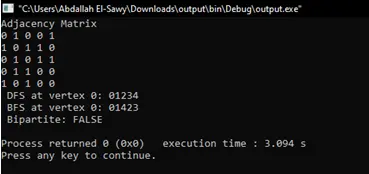Instructions
Objective
Write a C++ assignment class definition for an abstract data type called Graph that models an undirected graph.
Requirements and Specifications
Implement the following public member functions.
- Graph(char *fileName): A constructor that creates the graph using the file passed into the function.
- The format of the file is described later in the document
- Graph(): An appropriate destructor.
- void display() const: Displays the graph's adjacency matrix to the screen using this format (see examples later):
- Single space between digits.
- First row (top) and first column (left) is vertex 0, second row and column is vertex 1,…, last row (bottom) and last column (right) is vertex n – 1.
- void displayDFS(int vertex) const:Displays the result of a depth first search starting at the provided vertex.
- When you have a choice between selecting two vertices, pick the vertex with the lower number .
- bool isBipartite() const:Returns true if the graph is bipartite and false otherwise.
Screenshots of output

Source Code
// NAME:
// FILE: Graph.cpp
// DESCRIPTION: Implementation of the Graph class.
#include <iostream.h>
#include <fstream.h>
#include <cstdlib.h>
using namespace std;
#include <Graph.h>
#include <QueueInt.h>
#include <StackInt.h>
// Constructor: load the graph from a file
Graph::Graph(char *filename)
{
string line;
ifstream graphFile(filename);
graphFile >> this->numVertices;
this->createMatrix(this->numVertices);
int vertexA;
int vertexB;
int weight;
while (graphFile >> vertexA)
{
graphFile >> vertexB;
graphFile >> weight;
this->addEdge(vertexA, vertexB, weight);
}
graphFile.close();
}
// Destructor
Graph::~Graph()
{
for (int i = 0; i < this->numVertices; i++)
{
delete[] this->matrix[i];
}
delete[] this->matrix;
}
// Display the adjacency matrix
void Graph::display() const
{
for (int i = 0; i < this->numVertices; i++)
{
for (int j = 0; j < this->numVertices; j++)
{
if (i == j)
{
cout << 0;
}
else if (this->matrix[i][j] == -1)
{
cout << "x";
}
else
{
cout << this->matrix[i][j];
}
cout << " ";
if (j == this->numVertices - 1)
{
cout << endl;
}
}
}
}
// Displays the depth first search starting at the given vertex
void Graph::displayDFS(int vertex) const
{
cout << " DFS at vertex 0: " << vertex << ": ";
bool visited[this->numVertices];
for (int i = 0; i < this->numVertices; i++)
{
visited[i] = false;
}
this->dfsHelper(vertex, visited);
cout << endl;
}
void Graph::dfsHelper(int vertex, bool *visited) const
{
visited[vertex] = true;
cout << vertex << " ";
for (int i = 0; i < this->numVertices; i++)
{
if (!(visited[i]) && this->isAdjacent(vertex, i))
{
dfsHelper(i, visited);
}
}
}
// Perform breadth first search starting at the given vertex
void Graph::displayBFS(int vertex) const
{
cout << "BFS at vertex 0: " << vertex << ": ";
bool visited[this->numVertices];
for (int i = 0; i < this->numVertices; i++)
{
visited[i] = false;
}
QueueInt queue;
visited[vertex] = true;
cout << vertex << " ";
queue.enqueue(vertex);
while (!queue.isEmpty())
{
vertex = queue.dequeue();
for (int i = 0; i < this->numVertices; i++)
{
if (!(visited[i]) && this->isAdjacent(vertex, i))
{
visited[i] = true;
cout << i << " ";
queue.enqueue(i);
}
}
}
cout << endl;
}
int *Graph::mstNextEdge(bool *visited, int edge[]) const
{
edge[0] = -1;
edge[1] = -1;
edge[2] = -1;
for (int i = 0; i < this->numVertices; i++)
{
for (int j = 0; j < this->numVertices; j++)
{
int weight = this->matrix[i][j];
if (this->isAdjacent(i, j) && (visited[i] && !visited[j]))
{
if (edge[0] == -1 || edge[1] == -1)
{
edge[0] = i;
edge[1] = j;
edge[2] = weight;
}
int minWeight = this->matrix[edge[0]][edge[1]];
if (weight < minWeight)
{
edge[0] = i;
edge[1] = j;
edge[2] = weight;
}
}
}
}
return edge;
}
// Create 2D matrix
void Graph::createMatrix(int numVertices)
{
this->matrix = new int *[numVertices];
for (int i = 0; i < numVertices; i++)
{
this->matrix[i] = new int[numVertices];
for (int j = 0; j < numVertices; j++)
{
this->matrix[i][j] = -1;
}
}
}
void Graph::addEdge(int vertexA, int vertexB, int weight)
{
this->matrix[vertexA][vertexB] = weight;
this->matrix[vertexB][vertexA] = weight;
}
bool Graph::isAdjacent(int vertexA, int vertexB) const
{
return this->matrix[vertexA][vertexB] > 0;
}
// Determine whether the graph is bipartite or not
bool Graph::isBipartite() const
{
return false;
}
Related Samples
Explore our sample C++ assignments to witness our proficiency in tackling complex coding challenges. Each example showcases efficient, well-documented solutions, reflecting our expertise in C++ programming. Count on us for expert guidance and exceptional assignment solutions, ensuring your academic success and mastery of C++ concepts.
C++
C++
C++
C++
C++
C++
C++
C++
C++
C++
C++
C++
C++
C++
C++
C++
C++
C++
C++
C++